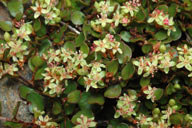In Flower This Week
A news sheet prepared by a Gardens' volunteer.
Numbers before each plant refer to temporary IFTW labels in the gardens.
Numbers in square brackets [ ] refer to garden bed Sections. Plants in flower are in bold type.
View past issues of 'In Flower This Week'.
21 January 2015
Muehlenbeckia axillaris click for larger image |
Take a walk today from the Visitors Information Centre (VIC) to the Rock Garden where there are plenty of interesting plants in flower.
- On the left across from the VIC look up to see Pandorea jasminoides [Section 212], a massive woody vine with plenty of pink bell flowers and shiny light green leaves. Also known as Bower of Beauty, the plant is native to New South Wales and Queensland, and forms large pointed pods filled with papery seeds.
- On the left of the entrance the VIC in a pot is Rhododendron viriosum [Section 221] with magnificent coral bell flowers on shiny dark green leaves. This is one of the few native rhododendrons in Australia, found in the high mountains of tropical northern Queensland.
- Walk up to the Rock Garden and start in front of the waterfall. Lythrum salicaria [Section 15v], or Purple Loosestrife, has terminal spikes of purple flowers which are very popular with bees. This interesting species is native not only to south-eastern Australia but widespread in Europe, Asia and North America.
- Go up the stairs to see on your left Leptospermum deuense [Section 15c], with white ‘tea-tree’ flowers on a neat bush. It is endemic to New South Wales.
- Further up the stairs on your right is Grevillea ‘Poorinda Royal Mantle’ [Section 15d], a vigorous groundcover with masses of red toothbrush flowers and persistent attention from the bees.
- Also on your right is Chrysocephalum apiculatum [Section 15d], with bright gold button flowers on a grey green groundcover plant. This daisy is found in all states and territories in Australia in a wide range of environments. With such a broad distribution it is not surprising that this species varies considerably in form, from a sparse erect plant to much lower sprawling forms.
- On your left and in many other places in the Rock Garden is Calostemma purpureum [Section 15b], or Garland Lily, with clusters of pink bell flowers on thin stems. lt is a well-known plant of the Riverina district, and is found in western New South Wales, north-western Victoria and South Australia.
- Calocephalus lacteus [Section 15b], or Milky Beauty-heads, is on your left with small white heads of flower on a grey green groundcover. It occurs naturally in south-eastern New South Wales, Victoria, Tasmania and South Australia.
- High on your left is Anigozanthos flavidus [Section 15h], a large clump of rusty red Kangaroo Paws.
- On the rocks on your left is Muehlenbeckia axillaris [Section 15h], forming a wiry mat of tiny rounded leaves with masses of small yellow flowers. It is native to New Zealand, as well as Tasmania, New South Wales and Victoria.
- Also on your left is Arthropodium milleflorum [Section 15h], commonly known as Vanilla Lily, with dainty pink vanilla-scented bell flowers on very thin stems. Turn back now along the same path and take the first left turn.
- High on the left is Acacia aneura var. aneura [Section 15l], commonly known as mulga, an open bush with gold balls of flowers on grey needle foliage. Mulga plants are believed to live as long as 400 years.
- On the left is Senecio linearifolius var. dangarensis [Section 15r], a tall grey-green shrub with yellow flower-heads.
- Eremophila bignoniiflora × polyclada [Section 15r], on the left, is an open bush with green linear foliage and large mauve bell flowers, fading to white.
- Hibbertia pedunculata [Section 15s], on the right, has tiny green foliage hugging the ground and showing off bright yellow flowers.
Follow the Main Path back through the Rainforest Gully as shown on the map overleaf.
Rosalind Walcott
![Director of National Parks [logo]](../../../../images/dnp_90px.gif)







